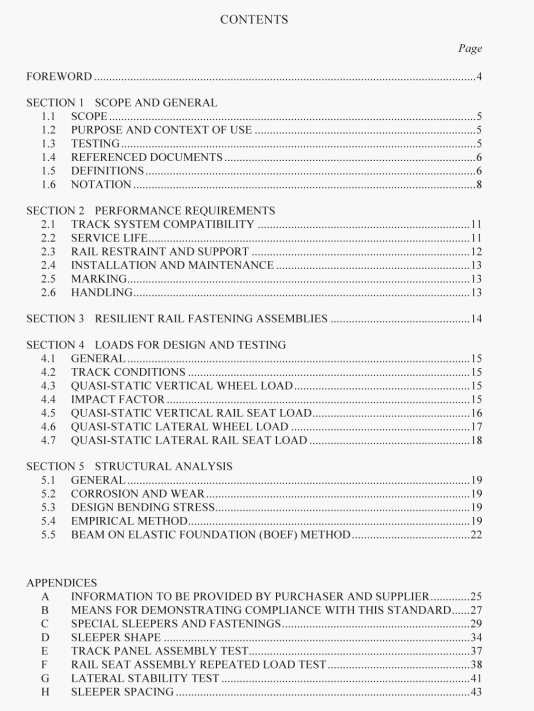AS 1085.17:2003 pdf – Railway track material Part 17: Steel sleepers.
4.1 GENERAL
Field measurements shall be used for determining loads to be used for testing and analysis. except that where field measurements are not available. Clauses 4.2 to 4.7 below set out theoretical means for calculating lateral and vertical loads.
Once determined, these loads are used for testing and for calculation of structural capacity.
NOTE: Quasi-static loads account for the effects of the geometrical roughness of the track vehicle response and the effect of unbalanced superclevation. Steel sleepers are not usually designed for high frequency dynamic load effects. Where steel sleepers are to be used in jointed track. dynamic effects may need to be considered.
4.2 TRACK CON flITIONS
All relevant track conditions shall be taken into account in determining the loading including dynamic effects. The efkcts of wheel flats, rail joints and other significant irregularities ill determine the magnitude of the dynamic loads used in design.
The methods given in Clauses 4.3 to 4.7 apply to the use of steel sleepers in ballasted railway tracks where they are installed either in-face or in an interspersed pattern. Where sleepers are to be used in an interspersed pattern, the possibility that a disproportionate amount of the load may he taken by a particular sleeper shall be taken into account in determining the variables to be tised (see Clause 4.5).
NOTES:
1 The purchaser should define track conditions (see Appendix A).
2 The purchaser should ensure that installation and maintenance procedures are suitable for the sleepers selected. including that the pod is correctly packed with ballast and that adjacent sleepers in an interspersed pattern are sound.
Where in-field measurements have not been obtained. the theoretical design quasi-static ‘ertical wheel load (Pdv) shall be determined from the maximum of a combination of static wheel loads and ehicle operating speeds in combination with the track condition factor as specified. The quasi-static wheel load shall be calculated from the following equation:
The empirical method is usually more conservative than the BOEF method.
Other methods of analysis may be used provided that they result in sleeper performance equal to or better than the performance resulting from the methods given in this Standard.
NOTE: A method for determining maximum sleeper spacing is given in Appendix H.
5.2 CORROSION AND WFAR
Alloisance shall he made for corrosion and wear appropriate to the specified sleeper design life, climate and corrosive environment in track. Section properties for use in design shall be appropriate to the expected sleeper cross-section at the end of the specified sleeper design life. In the absence of site-specific data, corrosion rates may be estimated in accordance with AS 2312.
NOTE: Corrosion should be assumed from both top and bottom surfaces. Consideration of higher corrosion and wear rates may be necessary where sleepers are used with reactive ballast or in poor ballast conditions.
AS 1085.17:2003 pdf – Railway track material Part 17: Steel sleepers
